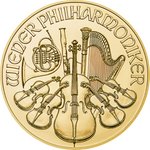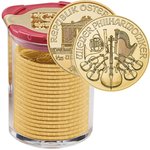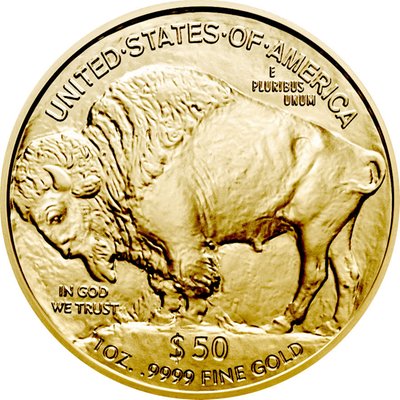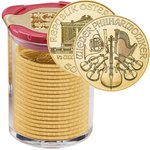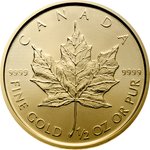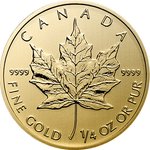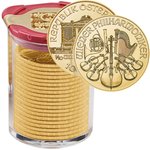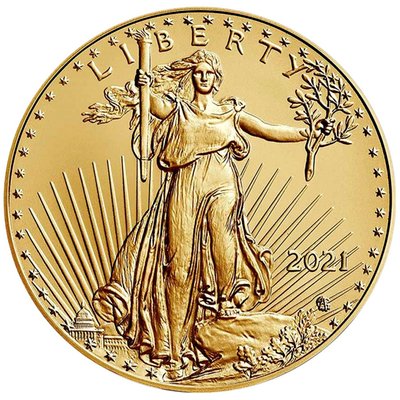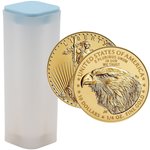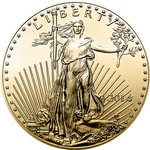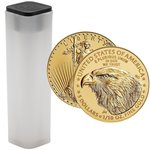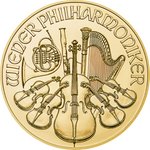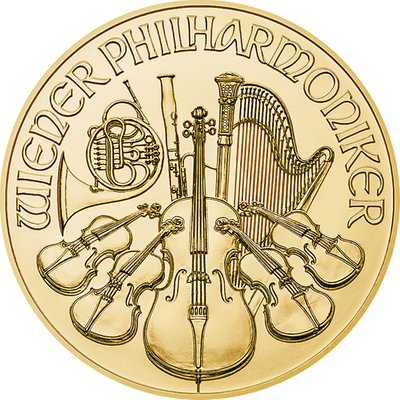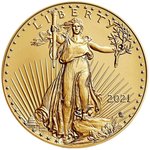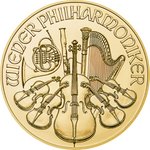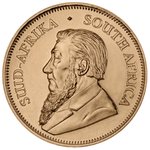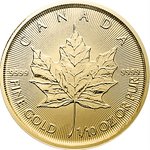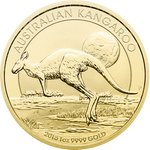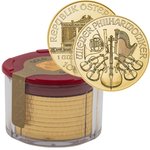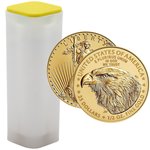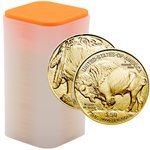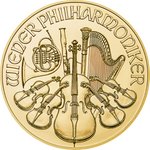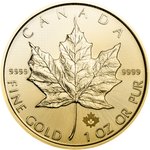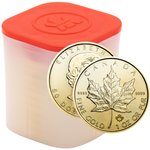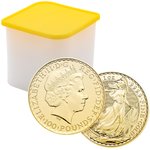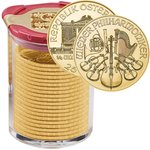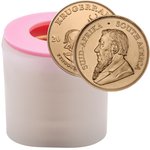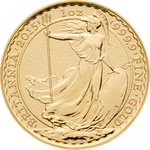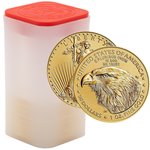Gold Coins
Reasons to buy gold coins from philoro
philoro has a wide network of international partners, consisting of the world's leading companies in the precious metals industry. A solid capital base and constantly increasing profits speak for philoro's success. We offer a wide range of precious metal products from the world's most renowned mints. philoro stands for high-quality service and professional advice from experts in the precious metals industry, as well as the security necessary to invest your assets profitably and wisely.
What should be considered when buying gold coins?
Consider well-known and popular coins!
Take your goals into account when purchasing gold products: traditional gold bars can only be resold in one piece. Therefore, it makes sense to mix gold coins and bars in different denominations (e.g., a 250 g gold bar and a 1 oz gold coin).
Pay attention to the difference between coins (which have a nominal value in an official national currency and are considered a form of payment) and medals. Keep in mind that physical gold must also be stored safely. Avoid buying gold for pure speculation. For further details and individual advice, please take a look at our FAQ section or contact us directly.
What denominations are there?
The troy ounce is a commonly used unit of mass for precious metals. The weight of a troy ounce refers to the precious metal content. The weight of bullion coins is expressed in ounces (1 ounce: 31.1035 grams). An exception is the popular Panda series from the China Mint, which has been traded in grams since 2016. The majority of gold investment coins are available as 1 ounce. In addition, there are smaller denominations, such as 1/25, 1/10, ¼, and ½ ounce.
| The most common forms of denominations are: |
|---|
| 1 ounce (31.10 g) |
| 1/2 ounce (15.55 g) |
| 1/4 ounce (7.77 g) |
| 1/10 ounce (3.11 g) |
| 1/25 ounce (1.24 g) |
| The most common forms of denominations are: | 1 ounce (31.10 g) |
|---|
| The most common forms of denominations are: | 1/2 ounce (15.55 g) |
|---|
| The most common forms of denominations are: | 1/4 ounce (7.77 g) |
|---|
| The most common forms of denominations are: | 1/10 ounce (3.11 g) |
|---|
| The most common forms of denominations are: | 1/25 ounce (1.24 g) |
|---|
Fineness of gold coins
Gold coins usually have a high fineness, such as 999/1000, which corresponds to 24 karats. Modern investment coins are fine gold coins with a fineness of 999.9/1000.
| Karat | Fineness |
|---|---|
| 24 karat | 999/1000 |
| 22 karat | 916/1000 |
| 18 karat | 750/1000 |
| 14 karat | 585/1000 |
| 10 karat | 417/1000 |
| 9 karat | 375/1000 |
| 8 karat | 333/1000 |
| Karat | 24 karat |
|---|---|
| Fineness | 999/1000 |
| Karat | 22 karat |
|---|---|
| Fineness | 916/1000 |
| Karat | 18 karat |
|---|---|
| Fineness | 750/1000 |
| Karat | 14 karat |
|---|---|
| Fineness | 585/1000 |
| Karat | 10 karat |
|---|---|
| Fineness | 417/1000 |
| Karat | 9 karat |
|---|---|
| Fineness | 375/1000 |
| Karat | 8 karat |
|---|---|
| Fineness | 333/1000 |
Why should I trust in gold coins?
If you are familiar with the history of currencies and understand the current currency and monetary system, you will most likely come to one conclusion: precious metals have proven to be good insurance against currency fluctuations or inflation crises.
Gold is not infinitely producible; demand is constant and increasing. These factors lead to a constant appreciation of gold. The assorted sizes/denominations of gold bars and coins offer a flexible design of assets. In addition, gold offers the security of having the option to sell it at any time, which is not always possible with other assets such as real estate.
What factors influence the value of gold coins?
The cost of an investment coin consists of two main factors: on the one hand, the pure material value, and on the other hand, production, and minting costs. This often leads to a price that is above that of the precious metal bar. The material value of the gold investment coin is based on the current stock exchange rate at the time of purchase.
What is the difference between a gold coin and a gold medal?
The characteristics of a coin are the minted year, the issuing country, the currency, and the nominal value, also called face value. The face value indication is a signal for the legitimate issuance of the coin. A medal, however, does not have face value and is not a legal tender. Gold medals are often minted to commemorate unique events or people, and are therefore more of a collector's item than an investment product.
What is the difference between a gold coin and a gold bar?
Gold coins are minted in a standardized form and weight, while gold bars can be produced in various shapes and sizes. Coins often have a higher premium, due to the additional minting and production costs. Gold bars are therefore typically the cheaper option for larger investors. However, gold coins are more portable and easier to store, making them an excellent choice for smaller investors or those who want to diversify their assets.
Interesting facts about gold coins
What did the first coins look like? Where did the coins come from originally? We take a trip to the beginnings, highs, and turning points of the history of gold coins, in the kingdom of the Persians, the Greek antiquity and the Roman Empire.
Croesus' coin reform
Croesus was the Lydian king who started the process that brought us the gold coin as we know it today. Lydia was a kingdom in modern-day western Turkey along the Mediterranean coast. He was known for his unimaginable wealth, which was based on the gold mined in his kingdom. In 560 BC, he carried out a coin reform. His father, Alyattes, had already established the minting of coins on an electrum basis in the kingdom. However, Croesus issued the first known gold coin with standardized purity. This replaced the electrum lumps in trade. Since then, silver and gold have developed into the leading coin metals. Croesus set the two precious metals in a fixed ratio to each other: one gold Croeseid, (name of the gold coin) weighing about 8 g corresponded to 10 silver Croeseid, (name of the silver coin). A new means of trade was born and spread from Anatolia along the Mediterranean coast throughout Greece.


The first 'world currency'
Alexander the Great was one of the most powerful generals of the fourth century BC. Through his conquests, he had amassed a vast amount of silver. This exceeded the silver possessions of any other Greek of his time. Instead of building a palace of silver, the Macedonian general issued one of the largest coin emissions of the ancient world. The reason was obvious: an army that is to wage war must also be paid, and this was done using Alexander's silver coins. The ruler’s coins were made in hundreds of mints across Europe and Asia. Despite this, the coins had an impressive uniformity that made them one of the first international silver currencies. The coin type minted under Alexander was continued long after his death, as his silver coin model was so popular.

Death by coin minting?
“Dictator of the Roman Empire” – this was the powerful title of Gaius Julius Caesar that he aimed to visualize. That is why he adorned the silver denarius with his portrait. This was considered a major taboo in ancient Rome, something that only the despotic kings of Greece had dared to do before. Just a few months after his appointment in 44 BC, Julius Caesar was murdered by the Senate.
Constantine's haven of security
Since the Gaius Julius Caesar’s rule, the silver content of the denarius decreased, and the currency gradually lost value. The denarius regressed into a copper coin. To counter the constant depreciation of the previous currency, Emperor Constantine wanted to mint a stable gold coin to replace the aureus, which had previously served as the Roman gold coin. This was the birth of the solidus (Latin for permanent, unshakable), introduced in 309 AD. Its name was more than justified and lasted over 1000 years until the conquest of Constantinople in 1453. Due to its widespread use and role as the "leading currency" in Europe, it is also referred to as “the Middle Ages' euro”.
The gold coin of the Middle East
What coins were prevalent in the Middle Eastern area? Which rulers adorned themselves with them? Which ones used them to wage war? One of the best-known gold coins of the Middle East is the dinar, whose name goes back to the Roman denarius. In 696, Caliph Abd al-Malik (from the Umayyad family, whose caliphate extended over large parts of Southwest Asia, North Africa, and the Iberian Peninsula) ordered a coin reform. The goal was to replace the Byzantine (or Eastern Roman) gold coins that were in use at the time, as Abd al-Malik waged several wars against the Byzantines, such as for control of Syria, Egypt, and Palestine. However, the model for this new coin was also a Byzantine coin, namely the solidus initiated by Constantine. Initially, the coin showed the portrait of the caliph. As part of the religious ban on images, the coin's motif changed. From then on, the design was determined by Muslim inscriptions. The word "dinar" is still used in the names of numerous currencies today, such as Algeria's or Tunisia's.

Gold coins of modern times
Gold coins remained the official means of payment in many countries and remained in circulation until the early 20th century. It was not until the turmoil of the First World War and the accompanying inflation, that precious metal coins disappeared as a means of payment. Today, gold coins are only minted for collectors or investors.
Which is the most famous gold coin?

In 1961, the rand replaced the South African pound, which at this time had been the currency in the former British colony. Even then, the rand gold coins had a 916.66 fineness and contained copper so that they would be hard and sturdy enough to be used as circulation coins. The fineness remained the same for the Krugerrand, which is why it is considered a 22-karat gold coin. The Krugerrand is also recognized as an official means of payment in South Africa.
The Krugerrand gold coin is manufactured and minted by the South African Mint/ Rand Refinery. In the first few years, the circulation was limited to 40,000 pieces. It was not until 1970, that the gold coin went into mass production. Eight years later, with more than 6 million 1 oz gold Krugerrand coins, it entered the history books. This number has not been reached by any other investment coin to date.
This coin was the first to be minted with the fine ounce in mind. Therefore, one fine ounce of pure gold, with a proportion of almost 3 grams of copper to increase scratch resistance, was created. In contrast, there are other investment coins, such as the Vienna Philharmonic, that consist exclusively of gold and have a 999.9 fineness and are therefore less resistant to pressure.
The release of the Canadian Maple Leaf gold coin increased the pressure on the South African Mint. As a result, the Krugerrand was also manufactured in half, quarter, and tenth ounce pieces, which have been available on the market since 1980.
Other well-known investment coins include the Vienna Philharmonic, the Maple Leaf, and the Kangaroo.

In 1933, the 32nd President of the United States, Franklin D. Roosevelt, suspended the production of the Double Eagle gold coin due to the world economic crisis. All banks in the country were prohibited from issuing money and minted coins. Americans were no longer allowed to hoard gold and had to exchange their gold coins for paper money. In addition, it was ordered that the entire 1933 edition of the Double Eagle be melted down before it was ever released.
Ten of the gold coins mysteriously disappeared into private hands. However, the owners could not do much with the stolen goods: the coins were not allowed to be issued officially, and even owning them was a crime.
Twenty years later, agents of the American intelligence agency tracked down the missing gold coins and were able to return the Double Eagles to their rightful place. However, one of the valuable coins remained untraceable. In 1956, the coin reappeared at an auction of the coin collection of the deceased King Farouk of Egypt, drawing the attention of American authorities.
When they wanted to prevent the sale of the coin, it disappeared again. It was not until 1996, that a British coin dealer accidentally offered the gold coin to two undercover agents in New York. At this point, the rarity could be seized and stored in a gold safe in Fort Knox, Kentucky, until it was legalized.
After the necessary bureaucratic steps, the Double Eagle could be auctioned off at the famous Sotheby's auction house in London. In July 2002, the gold coin was sold for $7.59 million to an anonymous bidder during a special one-off auction. The new owner of the famous gold coin also had to pay the face value of the coin, $20, to the US Treasury. The Double Eagle is therefore not only one of the most valuable, but also one of the rarest gold coins in the world.
However, if you considered both gold and silver coins, the Double Eagle would only come in second place. The most expensive coin in the world is a silver coin. The 1794 Liberty Silver Dollar is the first US dollar minted by the U.S. Mint and is worth $7.85 million.
How did the value of gold develop?
The value of gold depends on the price per troy ounce, which is determined by traders on the exchange and set anew every day. The demand for the precious metal is also a determining factor in the value of gold. Historical charts provide information on the development of the gold value over certain time periods. Looking at the performance of the last 10 years, a steady growth in the value of gold with rising prices can be seen.
In January 2007, the value of gold was still around $600 per troy ounce. In 2016, the value of gold peaked at around $970. In 2022, it reached a record value of $2,051.41 and has since been around the $1,800 mark. The value of gold has quadrupled in just under 15 years. The reason for the steadily increasing demand and therefore the appreciation of gold is that the supply of gold is limited. Gold cannot be artificially produced and remains valuable.
Gold is also attractive to buyers because it offers inflation protection. Increasing production costs due to inflation also contribute to the increase in the value of gold. Production costs include all costs incurred in the extraction of gold, such as wage costs. Inflationary circumstances can increase these costs, which flow into the gold price and further increase the price point of gold.
